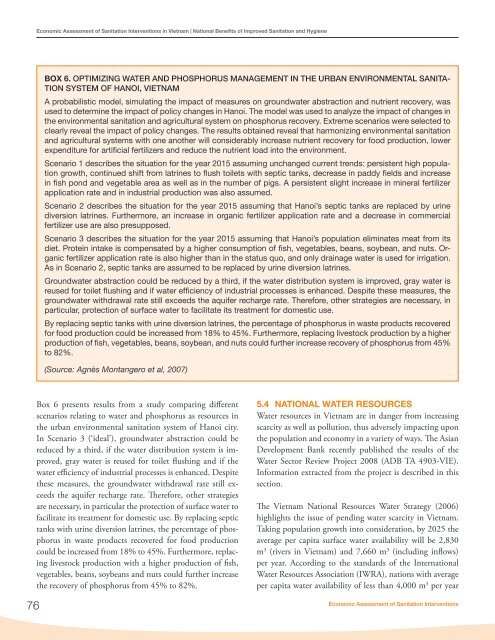Economic Assessment of Sanitation Interventions in Vietnam - WSP
Economic Assessment of Sanitation Interventions in Vietnam - WSP
Economic Assessment of Sanitation Interventions in Vietnam - WSP
Create successful ePaper yourself
Turn your PDF publications into a flip-book with our unique Google optimized e-Paper software.
<strong>Economic</strong> <strong>Assessment</strong> <strong>of</strong> <strong>Sanitation</strong> <strong>Interventions</strong> <strong>in</strong> <strong>Vietnam</strong> | National Benefits <strong>of</strong> Improved <strong>Sanitation</strong> and HygieneBOX 6. OPTIMIZING WATER AND PHOSPHORUS MANAGEMENT IN THE URBAN ENVIRONMENTAL SANITA-TION SYSTEM OF HANOI, VIETNAMA probabilistic model, simulat<strong>in</strong>g the impact <strong>of</strong> measures on groundwater abstraction and nutrient recovery, wasused to determ<strong>in</strong>e the impact <strong>of</strong> policy changes <strong>in</strong> Hanoi. The model was used to analyze the impact <strong>of</strong> changes <strong>in</strong>the environmental sanitation and agricultural system on phosphorus recovery. Extreme scenarios were selected toclearly reveal the impact <strong>of</strong> policy changes. The results obta<strong>in</strong>ed reveal that harmoniz<strong>in</strong>g environmental sanitationand agricultural systems with one another will considerably <strong>in</strong>crease nutrient recovery for food production, lowerexpenditure for artificial fertilizers and reduce the nutrient load <strong>in</strong>to the environment.Scenario 1 describes the situation for the year 2015 assum<strong>in</strong>g unchanged current trends: persistent high populationgrowth, cont<strong>in</strong>ued shift from latr<strong>in</strong>es to flush toilets with septic tanks, decrease <strong>in</strong> paddy fields and <strong>in</strong>crease<strong>in</strong> fish pond and vegetable area as well as <strong>in</strong> the number <strong>of</strong> pigs. A persistent slight <strong>in</strong>crease <strong>in</strong> m<strong>in</strong>eral fertilizerapplication rate and <strong>in</strong> <strong>in</strong>dustrial production was also assumed.Scenario 2 describes the situation for the year 2015 assum<strong>in</strong>g that Hanoi’s septic tanks are replaced by ur<strong>in</strong>ediversion latr<strong>in</strong>es. Furthermore, an <strong>in</strong>crease <strong>in</strong> organic fertilizer application rate and a decrease <strong>in</strong> commercialfertilizer use are also presupposed.Scenario 3 describes the situation for the year 2015 assum<strong>in</strong>g that Hanoi’s population elim<strong>in</strong>ates meat from itsdiet. Prote<strong>in</strong> <strong>in</strong>take is compensated by a higher consumption <strong>of</strong> fish, vegetables, beans, soybean, and nuts. Organicfertilizer application rate is also higher than <strong>in</strong> the status quo, and only dra<strong>in</strong>age water is used for irrigation.As <strong>in</strong> Scenario 2, septic tanks are assumed to be replaced by ur<strong>in</strong>e diversion latr<strong>in</strong>es.Groundwater abstraction could be reduced by a third, if the water distribution system is improved, gray water isreused for toilet flush<strong>in</strong>g and if water efficiency <strong>of</strong> <strong>in</strong>dustrial processes is enhanced. Despite these measures, thegroundwater withdrawal rate still exceeds the aquifer recharge rate. Therefore, other strategies are necessary, <strong>in</strong>particular, protection <strong>of</strong> surface water to facilitate its treatment for domestic use.By replac<strong>in</strong>g septic tanks with ur<strong>in</strong>e diversion latr<strong>in</strong>es, the percentage <strong>of</strong> phosphorus <strong>in</strong> waste products recoveredfor food production could be <strong>in</strong>creased from 18% to 45%. Furthermore, replac<strong>in</strong>g livestock production by a higherproduction <strong>of</strong> fish, vegetables, beans, soybean, and nuts could further <strong>in</strong>crease recovery <strong>of</strong> phosphorus from 45%to 82%.(Source: Agnès Montangero et al, 2007)76Box 6 presents results from a study compar<strong>in</strong>g differentscenarios relat<strong>in</strong>g to water and phosphorus as resources <strong>in</strong>the urban environmental sanitation system <strong>of</strong> Hanoi city.In Scenario 3 (‘ideal’), groundwater abstraction could bereduced by a third, if the water distribution system is improved,gray water is reused for toilet flush<strong>in</strong>g and if thewater efficiency <strong>of</strong> <strong>in</strong>dustrial processes is enhanced. Despitethese measures, the groundwater withdrawal rate still exceedsthe aquifer recharge rate. Therefore, other strategiesare necessary, <strong>in</strong> particular the protection <strong>of</strong> surface water t<strong>of</strong>acilitate its treatment for domestic use. By replac<strong>in</strong>g septictanks with ur<strong>in</strong>e diversion latr<strong>in</strong>es, the percentage <strong>of</strong> phosphorus<strong>in</strong> waste products recovered for food productioncould be <strong>in</strong>creased from 18% to 45%. Furthermore, replac<strong>in</strong>glivestock production with a higher production <strong>of</strong> fish,vegetables, beans, soybeans and nuts could further <strong>in</strong>creasethe recovery <strong>of</strong> phosphorus from 45% to 82%.5.4 NATIONAL WATER RESOURCESWater resources <strong>in</strong> <strong>Vietnam</strong> are <strong>in</strong> danger from <strong>in</strong>creas<strong>in</strong>gscarcity as well as pollution, thus adversely impact<strong>in</strong>g uponthe population and economy <strong>in</strong> a variety <strong>of</strong> ways. The AsianDevelopment Bank recently published the results <strong>of</strong> theWater Sector Review Project 2008 (ADB TA 4903-VIE).Information extracted from the project is described <strong>in</strong> thissection.The <strong>Vietnam</strong> National Resources Water Strategy (2006)highlights the issue <strong>of</strong> pend<strong>in</strong>g water scarcity <strong>in</strong> <strong>Vietnam</strong>.Tak<strong>in</strong>g population growth <strong>in</strong>to consideration, by 2025 theaverage per capita surface water availability will be 2,830m 3 (rivers <strong>in</strong> <strong>Vietnam</strong>) and 7,660 m 3 (<strong>in</strong>clud<strong>in</strong>g <strong>in</strong>flows)per year. Accord<strong>in</strong>g to the standards <strong>of</strong> the InternationalWater Resources Association (IWRA), nations with averageper capita water availability <strong>of</strong> less than 4,000 m 3 per year<strong>Economic</strong> <strong>Assessment</strong> <strong>of</strong> <strong>Sanitation</strong> <strong>Interventions</strong>
















